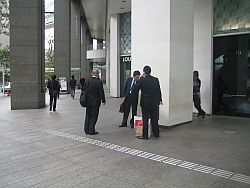Basic Japanese Business Etiquette

Like other areas of Japanese culture, Japan has its own unique rules of Japanese business etiquette. While as a foreigner doing business in Japan you will not necessarily be expected to know or conform to these rules, a basic grasp of the essentials of Japanese business etiquette will go along way toward making the right impression on your Japanese business partners or clients and in turn, increasing your prospects for a successful venture.
![]()
Japanese Business Practices – Introductions and Greeting
Japanese business meetings begin with formal introductions and the exchange of business cards (meishi). Here are a few tips regarding introductions:
 Always stand when your Japanese counterparts enter a room.
Always stand when your Japanese counterparts enter a room.
 Introduce yourself while presenting your business card (see below for more details on forms of address and proper exchange of business cards).
Introduce yourself while presenting your business card (see below for more details on forms of address and proper exchange of business cards).
 Remain very attentive to the introduction by your Japanese counterparts.
Remain very attentive to the introduction by your Japanese counterparts.
 If you are a guest at a company, remain standing until offered a seat. If you are the host, offer your Japanese guests a seat before sitting down yourself.
If you are a guest at a company, remain standing until offered a seat. If you are the host, offer your Japanese guests a seat before sitting down yourself.
 You may attempt to bow in the Japanese style, which will likely be appreciated by your counterparts. Handshakes are less common, but most Japanese business people are familiar with the practice, so be ready to receive handshakes if offered. Learn more about the custom of bowing in Japan.
You may attempt to bow in the Japanese style, which will likely be appreciated by your counterparts. Handshakes are less common, but most Japanese business people are familiar with the practice, so be ready to receive handshakes if offered. Learn more about the custom of bowing in Japan.
![]()
Japanese Business Etiquette – Exchange of Business Cards
In Japan, business cards, called “meishi” in Japanese, are the primary means of identification used when doing business. Meishi let the other party know not only what company you represent, but what your position is within that company, all of which is essential information for knowing how they should interact with you and you them.

When presenting your meishi, offer it in a formal fashion by holding it out in front of you face up with both hands. A little bow while doing this completes the process. Likewise, when receiving a meishi, do so with both hands and give a little bow in thanks, and then spend a moment or two studying the card.
Definitely do not stuff meishi you have just received into your pocket, as this is very bad Japanese business etiquette. If you are at a business meeting, keep the meishi out on the table in front of you, and then carefully put them away at the end of the meeting.
You will not be taken seriously as a business person without your meishi, so make sure to have some on hand at all times when doing business in Japan or with Japanese counterparts.
![]()
Japanese Business Practices – Forms of Business Address
Another aspect of Japanese business etiquette is the complex system of honorifics built into the language and culture that governs how persons engaged in business address one another.
Within a Japanese company, depending upon your relationship to your colleagues you may address others (or be addressed as) “XX-san” (formal), “XX-sama” (honorific), “XX-kun” (subordinate), “shacho” (president), “bucho” (manager) etc., or in some cases with no title at all.

The same forms of address are used when communicating outside of your own company with another company, although it must be emphasized that how they are used is entirely dependent upon the situation, so that a person addressed within the company by his superior as “Saito-kun” might easily receive a call five minutes later from a client who addresses him as “Saito-sama”, and then be addressed by a same-level colleague a moment later as “Saito-san”! Is your head spinning yet?
If you are working at a Japanese company, you should be familiar with the basic use of Japanese business address. Likewise, if your Japanese language skills are sufficient to attempt communicating in Japanese, a working knowledge of the way in which these titles are used is essential.
If you are only using the English language when doing business in Japan or with Japanese, you may address your counterparts as “Mr.” or “Ms.”, or as “XX-san”.
When addressing your Japanese counterpart as “-san“, be sure to use the last name of the person. Avoid addressing the person by his or her first name unless you are on very familiar terms and have been invited to do so by that person.
There is one other very important rule about use of titles that you need to know and abide by when doing business in Japan or with Japanese:
Whether you are speaking English or Japanese, when interacting with a business client or counterpart from another company using “-san”, never address yourself or someone from your own company as “-san”!
Therefore, when introducing or referring to yourself, never call yourself “XX-san“. Likewise, when introducing or referring to a colleague from your company (even the company president!), never call that person “-san” when speaking to a Japanese business counterpart.
![]()
Japanese Business Customs – Japanese Business Attire
Dress in business suits is another formal Japanese business custom. While Japan has relaxed its dress code somewhat in recent years, when visiting with a client or a prospective employer, a suit and tie is still pretty much mandatory.
The ideal Japan business suit is one that is black, dark gray, or perhaps navy blue. A white or lightly colored shirt and subdued tie completes the wardrobe. Business fashion in Japan tends to be conservative, so avoid too much flash in your business dress. Women should likewise dress conservatively in a blouse and skirt or a dark pants suit.
![]()
Japanese Business Etiquette – Gift Giving
When traveling to Japan to meet with a prospective or established client, it is customary to bring a gift from your country. See our Japanese Gift GivingSection for more information on the this ritual.
![]()
